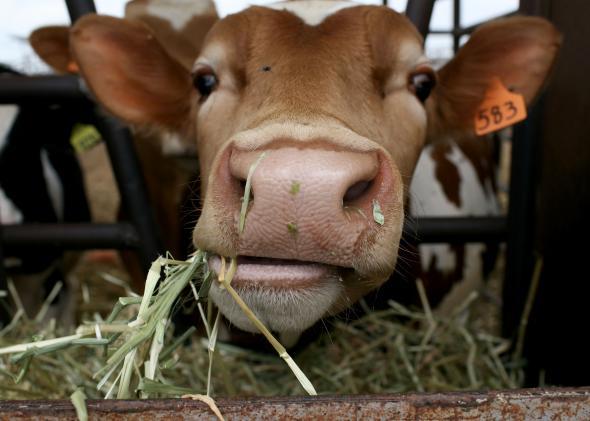While Obama’s Earth Day speech in the Everglades turned out to be a big nothingburger—except if you’re the parent of a fourth-grader who’ll now receive a free annual National Park pass—there are renewed signs this week that his nickel-and-dime approach to fighting climate change is finally starting to pay off.
I’ve been critical of the president’s climate policy in the past for lacking ambition. Even the much-celebrated deal with China last year only puts our planned domestic carbon cutting at about the middle of the pack, globally. We need to do much more than that to “lead the world,” as Obama said on Wednesday. The proof is in the numbers: America’s greenhouse gas emissions have now risen two years in a row, while global emissions last year stayed flat.
But the fact that current U.S. climate policies probably don’t yet match with our stated goal of reducing emissions by 26-28 percent in the next 10 years is partially offset by Obama’s growing climate influence abroad. We’re not yet leading the world on fighting climate change, but at least we’re not being as willfully obstinate as we had been during past administrations.
On Wednesday, as the president spoke in the Florida swamp, diplomats were gathering in Bangkok to discuss a possible global deal to phase out hydroflorocarbons (HFCs), one of the fastest growing contributors to climate change. This deal wouldn’t be possible without help from the Obama administration.
HFCs, which are used primarily as refrigerants in air conditioning, were phased in as a replacement for CFCs in the 1980s and 1990s in an attempt to stop the growth of the hole in the ozone layer. Since then, they’ve become a big problem in and of themselves—even though viable alternatives are readily available.
A pound of HFCs has up to 14,000 times the global warming potential as a pound of carbon dioxide. U.S. emissions of HFCs are the largest of any country in the world, and they’re rising—but they’re soon to get dwarfed by demand for cooling in places like India as the climate warms and the global middle class of people who can afford air conditioning expands. The proportion of humanity’s total impact on the climate by HFCs is projected to grow rapidly in the coming decades—and could amount to 28 to 45 percent of all human-induced global warming by 2050 if the world cracks down on carbon dioxide in the meantime.
So what’s the good news? Air conditioning is a life-and-death issue in India, where its use is projected to grow at a whopping 20 percent per year for the foreseeable future. India had been opposing a transition to HFC alternatives to allow the greatest access to cooling possible. But a big breakthrough on HFCs came earlier this month when India unexpectedly submitted a plan for their global phase-out using the existing Montreal Protocol—the same treaty used to phase out CFCs decades ago. Lead U.S. climate diplomat Todd Stern claimed victory, crediting a bilateral meeting between Obama and Indian Prime Minister Modi in January. The U.S. and China had previously agreed to a similar deal on HFCs in 2013, and the Obama administration announced a voluntary deal with American cooling-intensive companies, like Coca-Cola, last fall.
Because the structure of this year’s first-ever global agreement on climate change is also voluntary—with each country effectively trying to peer-pressure others into greater cuts—it matters that the Obama administration is emerging as an effective negotiating force. India hasn’t yet announced its overall economy-wide goal for cutting carbon, but is rumored to be leaving the door open for more significant cuts should wealthier countries agree to fund them.
Back home, the Obama administration is also flexing its powers of suggestion this week within the agriculture sector—a group not particularly known for its outspoken desire to tackle climate change.
Next to carbon dioxide, methane is the most important greenhouse gas, and is 86 times more powerful, pound-for-pound. Because of manure management and, yes, cow belches, agriculture is a bigger emitter of methane than the entire oil and gas industry. Agricultural methane emissions have been growing over the last decade, even as overall U.S. emissions declined.
On Thursday, the Obama administration announced a “comprehensive approach” to enlist American farmers in a voluntary effort to cut greenhouse gases—carbon dioxide, methane, and nitrogen oxides—through programs and incentives designed to reduce fertilizer use, encouraging tree planting, and turn poop into power by capturing methane. The moves will save an estimated 120 million metric tons of carbon dioxide equivalent per year by 2025, closing the gap by about a third between his economy-wide pledge and the sum total of all of Obama’s myriad executive actions and regulations on climate thus far.
Now that Obama has targeted power plants, vehicles, government buildings, the agriculture sector, the fossil fuel industry, and advocated for a plant-based diet, there isn’t much low-hanging fruit left. Hamstrung by an unwilling Congress, Obama’s climate team has accomplished about all they can by going the voluntary route. The next step will be attempting a bi-partisan economy-wide carbon cap—a feat that will probably fall to the next president.
